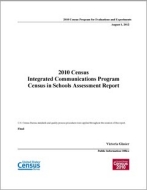2010 Census Integrated Communications Program Census in Schools Assessment Report
2010 Census Integrated Communications Program Census in Schools Assessment Report
Executive Summary
The purpose of the 2010 Census in Schools program was to provide educators with resources to teach the nation’s students about the importance of the census so children could help deliver this message to their families. The program was designed to engage America’s youth and to help ensure every child and every household member was counted in the 2010 Census.
The Census In Schools program had three components: (1) national and regional outreach to state and district level school administrators, chairpersons of boards of education, parent - teacher organizations, school principals, social studies coordinators, teachers, and students; (2) partnerships with the U.S. Department of Education and national and local educational organizations; and (3) lessons and related materials for Kindergarten though twelfth grade students and their teachers, developed in partnership with Scholastic, Inc.
This report will assess the activities of the 2010 Census in Schools program, which was part of the 2010 Census Integrated Communications Program. The goal of the Census in Schools program was to increase awareness and overall public response for the 2010 Census by engaging teachers, students and their households in public conversations about the 2010 Census. The Census Bureau subcontracted with Scholastic, Inc. under the Draft FCB contract to help with this effort.
Through Census in Schools, educators in public, charter, private, parochial, tribal, and home schools were given access to 2010 Census lessons, materials, and event ideas designed to teach students and their households about the census’ role in U.S. history, current events, and more. The education component was tailored to serve Kindergarten through twelfth grade students in stateside schools, the District of Columbia, Puerto Rico, and every student in Kindergarten through eighth grade in American Samoa, Guam, the U.S. Virgin Islands and the Commonwealth of the Northern Mariana Islands. There also were separate components for stateside Kindergarten through eighth grade students enrolled in English language learners’ classes, stateside Kindergarten through fifth grade diversity lessons and lessons for adult students enrolled in stateside English as a Second Language classes. Classroom materials were available in English and Spanish and take home materials were available in 25 additional languages. All Census in Schools materials were available on the Census Bureau’s and Scholastic’s websites.
The planning and implementation of the program involved contractors, stakeholders, partners and internal program areas. Sessions with staff and contractors produced valuable lessons learned. There were many recommendations for the Census in Schools program. Some high level recommendations to guide planning for the 2020 Census in Schools program include:
- Census in Schools lesson plans and materials should comply with state or local formal curriculum.
- Census in Schools materials should be given to regional partnership staff as part of their initial training.
- Plan for the 2020 Census with a scalable model, both larger and smaller depending on the budget, of the desired Census in Schools materials that are to be developed, identifying target audiences for each component.
- Utilize partnerships as an ongoing process with national professional educational associations as a supportive vehicle for dissemination of the Census in Schools program.
- Maintain a Census Bureau website for the 2020 Census in Schools program.
Others in Series
Publication
Publication
Publication






